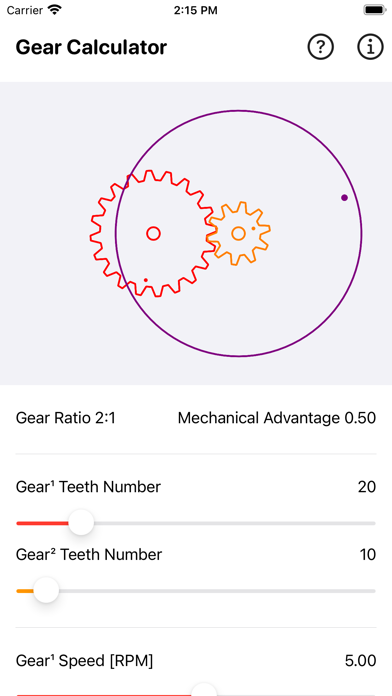
Gear Simulation & Calculation
Gear Simulation and Calculation calculate the gear ratio, torque and speed of gears train system.
Plus quickly simulate how the gear train work on the fly.
This is a great tool especially for DIYer who want to design their own Gears Train System quick and easy.
Preview how these system work before 3D print own gear system.
Features:
∙ Calculate gears fast and easy with parameter
∙ Input gear teeth number
∙ Output gear teeth number
∙ Input gear speed [rpm]
∙ Output gear speed [rpm]
∙ Input gear torque [Nm]
∙ Output gear torque [Nm]
∙ Output wheel diameter [in/cm]
∙ Calculate wheel speed [mph/kmh/ms⁻¹]
∙ Calculate Gear Ratio
∙ Calculate Mechanical Advantage
Formula:
Gear Ratio = input gear teeth number / output gear teeth number
Mechanical Advantage = output gear teeth number / input gear teeth number
Wheel Speed = output gear speed * wheel diameter * .pi * 60 / 63360
Law of Gearing:
T1/T2 = d1/d2 = n1/n2 = ω1/ω2
T1 and T2 = Number of Teeth on driver and driven gear respectively.
d1 and d2 = driver and driven gear diameter respectively.
n1 and n2 = Gear Speed in RPM for driver and driven gear respectively.
ω1 and ω2 = Angular Velocity in radian/sec for driver and driven gear respectively.
A gear is a circular machine element that can control the rotational movements direction, torque, and speed. Gears are a necessary component of any machine having moving parts, such as a wristwatch or a car. are important components in modern engineering. A Gear train consists of two or more gears in series. It is used to increase or decrease the speed or torque of the output shaft.
The Gear Calculator calculates the mechanical advantage of a two-gear system in a machine. The gear ratio indicates how much a systems output gear is sped up or slowed down, as well as how much torque is lost or gained.
Gears available in a variety of shapes and sizes (the most common are involute gears), and these distinctions indicate how the rotating movement is translated or transferred. When two or more gears in a system mesh together while in motion, movement is transmitted. This set of gears is referred to as a gear train.
In a gear train, the gear ratio is the ratio of the input gear circumference to the output gear circumference. The gear ratio is used to calculate the number of teeth required for each gear to achieve the specified output speed/angular velocity, or torque.
Mechanical advantage in terms of torque
Riding a bike uphill is easier if you use a low-speed gear. When you do this, you get more torque and more power when travelling uphill.
Mechanical advantage in terms of speed
Hand drills are a good example of a simple machine that has a mechanical speed advantage. The drill bit spins at a high speed when the handle is cranked.
Thanks for your support and do visit nitrio.com for more apps for your iOS devices.



